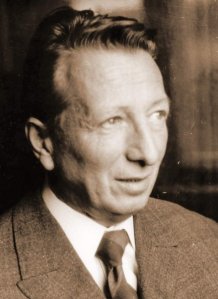 On October 10th 2006, the Romanian academic community suffered a great loss, the passing away of Professor Mircea Mihailescu, an undeniable valuable, dynamic personality. Blessed with a tremendous energy, he worked until his last day, leaving behind several unfinished projects, due to a sudden heart attack. He was 86. He is survived by his son Dan-Nicolae Mihailescu, a civil engineer, and two grandchildren, Tudor-Mircea Mihailescu and Monica-Alexandra Mihailescu Suma.
On October 10th 2006, the Romanian academic community suffered a great loss, the passing away of Professor Mircea Mihailescu, an undeniable valuable, dynamic personality. Blessed with a tremendous energy, he worked until his last day, leaving behind several unfinished projects, due to a sudden heart attack. He was 86. He is survived by his son Dan-Nicolae Mihailescu, a civil engineer, and two grandchildren, Tudor-Mircea Mihailescu and Monica-Alexandra Mihailescu Suma.
To do justice to his career of over 60 years is difficult. He was a respected, highly skilled, dedicated professor and chairman of the Department of Reinforced Concrete, at the Technical University of Cluj-Napoca, where he taught for 42 years, mentoring 26 classes of graduate students in civil engineering. In recognition of his lifelong dedication, the university awarded him the Doctor Honoris Causa title, in a gala ceremony, in May 2002.
Born in Brasov on October 1st 1920 into a family of intellectuals, his father Nicolae and mother Ecaterina provided him an outstanding education. The greatest lesson his father – a general in the pre-war Romanian army – taught him, was to fight for justice, defend one’s country and above all, behave with honor, principles he closely abided to for the rest of his life. His gravestone (which he himself paradoxically designed a few days before his death) lies as a testament of his morals, into which the words Onoare si patrie (Honor and Patriotism) are carved. Mircea attended the prestigious Andrei Saguna High School in Brasov where Emil Cioran, his teacher of philosophy, had a considerable influence on the young disciple. He went on to The Bucharest Polytechnic, graduating in 1944, honored with the Vasile Karpen Award of the University.
In 1950, he married Mihaela Savulescu, a lawyer, and daughter of a well-known doctor and professor Dumitru Savulescu and doctor Niculina Savulescu. His only child, Dan-Nicolae, was born February 1952. They divorced in 1956. He remarried in 1958 to Yvonne Ionascu, a civil engineer as well, and daughter of eminent history professor Ion Ionascu. They were married an impressive 46 years, until she lost the battle against cancer in 2004.
He published over 175 papers in the field of reinforced concrete spatial structures in Romanian and foreign journals and for 38 international congresses. Apart from his scholarly contributions, he was renowned as designer of structures. His unique touch of innovation surfaced from the landmark buildings that he designed; among the most well-known are the Brasov Railway Station (1947 and 1967), the Olanesti Well Station (1960), the Predeal Railway Station (1964), the Onesti Sports Hall (1966), the Cluj-Napoca Exhibition Hall and the legendary Casa Presei Libere of Bucharest (House of the Free Press; 1949-1954).
After the collapse of communism in 1989, he entered politics, becoming a regional leader of the Peasants National Christian Democrat Party, working along the leader of the party at the time, Corneliu Coposu. However, his involvement in politics was short-spanned, returning to what he enjoyed most, design structures and teach.
Throughout his eminent career, he was repeatedly recognized for outstanding achievement, being presented with The Aurel Vlaicu Award, by the Romanian Academy (1957), The Ministry of Education Award (1967), The Ministry of Industrial Constructions Award (1978), the Jubilee Badge and Award of the Institute for Research and Design in the Chemical Industry (1979) and Builder of the XX century (2001). His name was included in Ingénieurs du Siècle published in 1997 by Georges Pompidou publishing house. A repeated key-note speaker for IASS (International Association of Shell and Spatial Structures) conferences, in places such as Japan, Australia, Turkey, Singapore, England, in 2005, he received his last and most impressive international title, that of Honorary Member. In that same year, he was the organizing chair of the IASS Symposium held in Bucharest and Poiana Brasov, Romania, 6-9th September.
His greatest ambition was to excel in his profession, inspiring those around him to do the same. He was often intimidating, because of his vast knowledge, impeccable manners, refined taste, and elegant attire. He would never be seen in anything less than the finest suit, portraying the best image in respect to his fellow peers. The same presence was evident in honoring his family by sharing faultless formal family dinners. He treasured his family – often times worked along his son Dan, who became a brilliant civil engineer in his own right – and took tremendous pride in his grandchildren. Well into his 60s and 70s, he would often play tennis with his talented young grandson Tudor. It was always a spectacle to watch, they were both very good and very much alike, blond and quick on their feet. Later on, they would have extensive clever discussions over business matters of the world. As for graceful little Monica, the youngest of the Mihailescu clan, he would treat her as a princess, inviting her to the Opera, teaching her about music, painting, and poetry, and buying her fine jewelry from places he had been around the world.
His was a remarkable life. He was my grandfather, and he is greatly missed.
